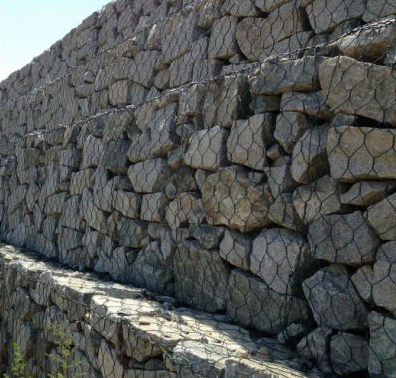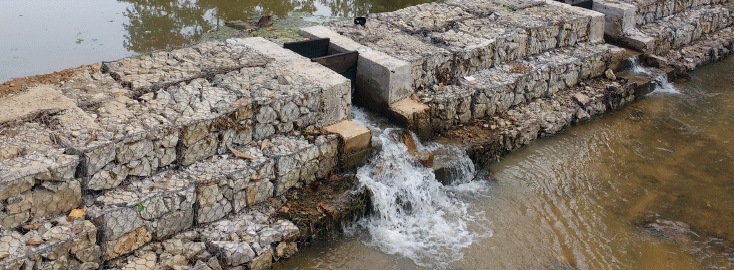
Urban Rewilding
One-Pager: Gabion dams and Rewilding
Hari Srinivas One-Pager Series C-065
Adding Gabion Dams Upstream: A Dual Solution for Groundwater Recharge and Flood Prevention in Rewilded Urban Areas
The word Gabion originates from the Italian word "gabbione," which means "big cage" or "basket." Gabions are essentially wire mesh containers or baskets filled with rocks, stones, or other materials. They have been used for centuries in various civil engineering and construction applications due to their effectiveness in erosion control, retaining walls, and other structural purposes, including in dam construction.

Urbanization and its associated infrastructure often lead to a multitude of environmental challenges, including groundwater depletion and increased susceptibility to flooding. This one-pager explores the concept of utilizing Gabion dams upstream in rewilded urban areas as a sustainable solution to address these pressing issues.
Gabion Dams:
Gabion dams are structures constructed using wire mesh containers filled with rocks or other locally available materials. They have been employed for centuries for various purposes, including flood control and erosion prevention. In recent years, they have gained recognition for their potential to enhance urban ecosystems.
The integration of Gabion dams upstream in rewilded urban areas presents a dual solution to critical challenges. Not only does it help recharge groundwater and prevent flooding, but it also contributes to the creation of more sustainable and livable urban environments.
- Groundwater Recharge:
- Natural Water Filtration: Gabion dams act as natural water filters by slowing down the flow of surface water. As water passes through the rocks within the Gabion structure, impurities are filtered out, leading to improved water quality.
- Groundwater Replenishment: The controlled release of water from Gabion dams allows for gradual percolation into the underlying aquifers. This process recharges groundwater reservoirs, which are vital for sustaining urban water supplies.
- Flood Prevention:
- Stormwater Management: Gabion dams effectively manage stormwater runoff by slowing down and temporarily storing excess rainfall. This reduces the risk of flash flooding in urban areas during heavy rain events.
- Erosion Control: Gabion dams mitigate soil erosion by preventing the rapid flow of water. This protection of the soil and riverbanks contributes to the overall stability of the urban landscape.
- Rewilding Urban Areas:
Rewilding involves restoring natural processes and biodiversity within urban environments. Combining Gabion dams with rewilding initiatives offers numerous benefits:
- Biodiversity Enhancement: Gabion dams create diverse habitats for flora and fauna, promoting urban biodiversity.
- Aesthetic Appeal: Naturalized water features and green spaces improve the aesthetic value of urban areas, making them more enjoyable for residents.
- Community Engagement: Rewilded spaces often encourage community involvement in conservation efforts and foster a sense of stewardship.

- Examples:
- Tokyo, Japan: Tokyo and its surrounding areas have implemented various flood control measures, including Gabion dams and levees along rivers and streams. These structures help manage water flow during heavy rainfall and reduce the risk of flooding in densely populated urban areas. Gabion dams have also been used in mountainous slopes to prevent landslides and reduce flood flows.
- Seoul, South Korea: Seoul has employed Gabion dams and check dams along the Han River and its tributaries to control flooding and erosion. These structures are part of a broader effort to improve the city's water management and enhance its green infrastructure.
- Shanghai, China: Gabion dams and similar structures have been used in Shanghai and other Chinese cities to address flooding issues, particularly during the monsoon season. These measures are integral to the city's flood control strategies.
- Dhaka, Bangladesh: Dhaka, prone to flooding due to its low-lying geography, has experimented with Gabion dams and other flood control structures along its rivers and canals. These efforts aim to mitigate the impacts of annual monsoon floods and protect vulnerable urban areas.
- Colombo, Sri Lanka: Gabion dams and revetments have been utilized in Colombo to manage water flow in urban waterways and mitigate erosion. These structures play a role in the city's overall flood control and urban water management plans.
This approach showcases the potential for innovative, nature-based solutions to address the complex issues associated with urbanization while promoting harmony between human and natural systems.
|
|
| Return to Urban Rewilding Contact: |
